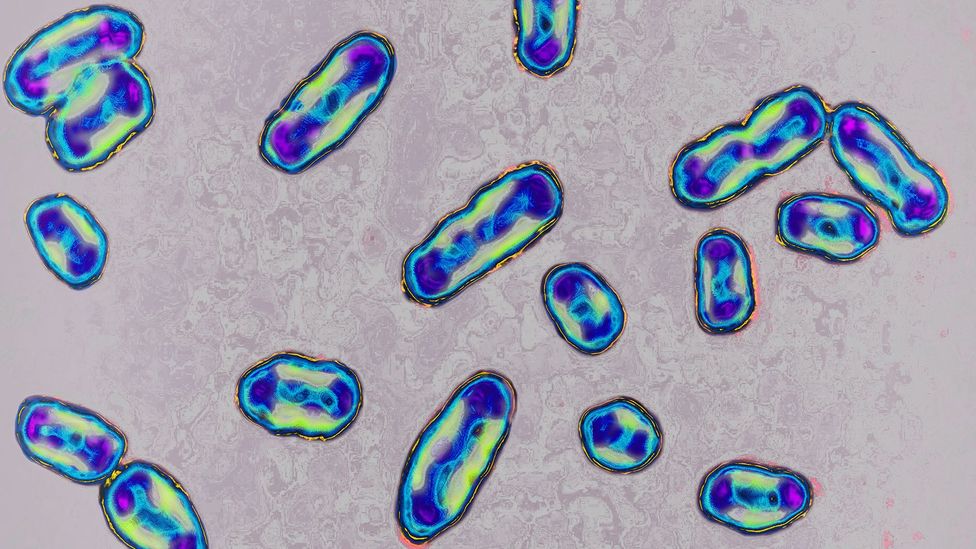Under the microscope, Yersinia pestis doesn't look particularly special. It's a fairly standard shape for a bacterium – a sort of short, round-ended rod – and relatively immobile. But it is responsible for a disease that once wiped out a third of Europe's population and caused millions of deaths around the world.
The very mention of the words bubonic plague tends to provoke both fear and fascination even today. The disease is now vanishingly rare in both the US and Europe, largely thanks to changes in lifestyles that prevent it from spreading to humans from infected fleas as easily. Even when it does occur, it can be relatively easily treated with antibiotics, saving lives. But cases still do occur.
Most recently, a man in Oregon in the US, caught the bubonic plague from his pet cat. It is not something that comes as an enormous surprise to evolutionary geneticist Paul Norman, who studies bubonic plague at the University of Colorado, Anschutz.
"There still are little pockets of plague in the US," he says. It still circulates in wild animals such as squirrels and prairie dogs, he adds. On average, around seven cases of plague in humans are reported in the US each year, although deaths are far less common with just 14 between 2000-2020. In some parts of the world, such as Madagascar, the disease is more common.
But even though it is relatively rare compared to the past, the bubonic plague has left its mark on the human species and can still be found in the genomes of people living today.
Yersinia pestis is thought to have plagued the human species for thousands of years. DNA evidence of the bacteria has been found in skeletons dating back 4,000 years. But in the early 1300s, a strain of the bacteria exploded into Europe as the Black Death. It is thought to have originated in villages around the Chui Valley what is now Kyrgyzstan, perhaps passing through fleas from infected marmots into people before then spreading to Europe along the Silk Road trade route.
The Black Death is thought to have killed about 50 million Europeans by the mid 1300s, according to estimates based on historical records and accounts. More recent research on agricultural activity at the time – which would have plummeted amid so many deaths – has suggested that the toll may not have been so dramatic everywhere, with some regions being devastated by the disease and others barely touched. Over the centuries, however, plague is estimated to have killed at least 200 million people.
Because plague outbreaks were so catastrophic, researchers have long wondered whether they left some permanent imprint on the human immune system. In particular, one theory suggests that the Black Death could have been widespread enough in the 14th Century to have created a form of natural selection. The idea was that some of the individuals who survived it were able to pass on any genetic quirks that helped them do so to future generations.
"The Black Death put a huge pressure on the human population in Europe," says Norman. "It was persistent and damaging, and anybody with the slightest advantage in that situation through their genetics would have been more likely to survive."
But until relatively recently, gathering any kind of data to answer this question was next to impossible. Sequencing DNA from the skeletons of ancient plague victims found in mass burial sites is notoriously challenging, with scientists often having to work with the tiniest fragments of DNA, many of which are highly contaminated.
"It’s quite common to find that the majority of the DNA is actually from the soil or bacteria which have invaded the skeleton after the person died," says Swedish geneticist Pontus Skoglund, who leads the ancient genomics laboratory at London’s Francis Crick Institute.
Experts have discovered, however, one piece of the skeleton where intact human DNA can still be reliably found. Called the bony labyrinth, it lies within the inner ear and is one of the densest parts of the human body. "It's the most successful place to extract DNA from," says Norman. "It’s a very, very tiny bone which is still protected in skull specimens. Without wanting to get too grisly, you have to really drill into the skull to get that bit of bone, while something like the leg bone is extremely porous and bacteria get in there much more easily."
Over the last three years this has helped yield new insights into who survived past plague outbreaks and why.
Regulating immunity
The human leukocyte antigen (HLA) system consists of a group of genes that encode proteins on the surface of our cells, which play an important role in co-ordinating the immune response. A recent study has shown that some people who were asymptomatic to Covid-19 benefitted from a genetic lottery which meant they had certain HLA variants that acted as a form of natural protection against the virus.
"The role of HLA genes is to identify foreign invasion in the body and direct the immune system to seek out cells infected with pathogen proteins and destroy them," says Norman. "Relatively rare variants of these genes can help some people survive a pandemic, and if Covid fatalities had been a lot higher, the human population would have been left with a much higher frequency of these variants."
Anybody with the slightest advantage in that situation through their genetics would have been more likely to survive – Paul Norman
In 2021, Norman and his colleagues demonstrated that HLA variants likely played a role in determining who survived medieval plague outbreaks. The researchers investigated a mass grave of plague victims from the 16th Century in the German town of Ellwangen, and sequenced genomes from 36 skeletons. When they compared them with the DNA of people living in Ellwangen today, they found that the town’s 21st century inhabitants had subtle differences in various HLA genes, which likely rendered their ancestors more capable of fighting off Yersinia pestis.
Two years ago, an international group of researchers sought to examine how the Black Death might have impacted human immunity by gathering genetic samples from the skeletons of around 500 people in cemeteries in London and across Denmark who died before, during and after the 14th-Century pandemic.
In particular, they noted patterns relating to a gene called ERAP2 which encodes a protein known to help human immune cells fight off Yersinia pestis and other pathogens. But one variant of ERAP2 produces a more limited form of the protein, while another yields a full-sized protein.
The study showed that medieval Londoners and Danes who carried the latter ERAP2 variant were twice as likely to have survived the Black Death. By the end of the 14th Century, the researchers found that 50% of Londoners and 70% of the Danes surveyed, carried this variant.
However, we still need to learn more. Skoglund says researchers need to study thousands more genomes from individuals living across Europe at the time of the Black Death and over subsequent centuries, to see whether adaptions such as the ERAP2 variant became truly widespread and integrated into our DNA.
"Any genes that had a protective effect against this outbreak could have had quite a boost in frequency after such an event," he says. "But this may have only been over a few generations."

Madagascar still suffers from outbreaks of bubonic plague, which occasionally occur in urban areas, leading to heightened concerns among health authorities (Credit: Getty Images)
Skoglund even wonders whether diseases such as smallpox, which was even more persistent and virulent than plague, killing many hundreds of millions of people, could have had a greater impact on shaping modern immune systems.
But plague retains a particular fascination, and we can gain valuable information from studying how it impacted our distant ancestors. "Looking at how plague evolves and why certain strains may have been more virulent in terms of mortality is important for understanding the evolution of strains that can become problematic," says evolutionary biologist Hendrik Poinar at McMaster University in Ontario, Canada.
Skoglund points to a study he did of plague victims found in Somerset and Cumbria in the UK from around 4,000 years ago when Yersinia pestis had yet to develop the ability to be spread by fleas.
"We can see in the DNA that the bacteria lacked a genetic factor that allows this flea-based transmission," he says. "But by evolving that, it had a drastic impact on human health. But we can also learn from how evolution dealt with problems in the past, how it came up with biological mechanisms to battle those diseases thousands of years ago. That’s vital because we can use that to help us with vaccines and drug development today."
--
If you liked this story, sign up for The Essential List newsletter – a handpicked selection of features, videos and can't-miss news delivered to your inbox every Friday.
Join one million Future fans by liking us on Facebook, or follow us on Twitter or Instagram.
